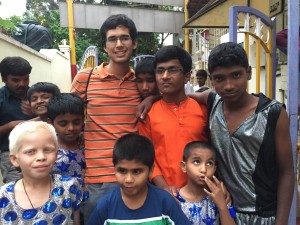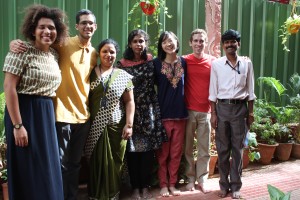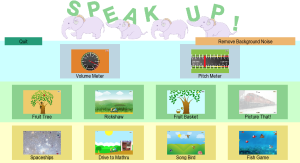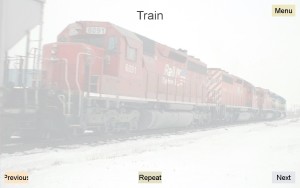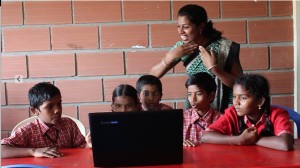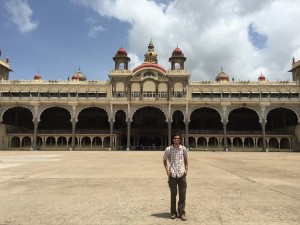Before this summer, I was completely certain that after graduation I would work at a Silicon Valley startup, enjoying the benefits of free meals and a gym at work. After participating in the iSTEP internship, I feel that many of these startups and tech companies make luxury products for a very thin slice of society, and that there are ways that technology, and the skills I will learn in the coming years, can be used for more meaningful and impactful change. How did this change come about? It was really the ICTD work I saw, experienced, and helped complete at the Mathru Educational Trust for the Blind.
What is ICTD? ICTD, which stands for Information Communication Technology and Development, is a very young field that studies the relationships between technology and development. It has many facets, including studying how developing communities use and get access to technology, how technology affects developing communities, how technology can be developed to bridge gaps in developing communities, etc. At the center of ICTD work is the community, and hence most ICTD projects involve spending time with the community to learn about them, their needs, and where technology can come in. ICTD projects also tend to focus on making the technological sustainable, low-cost and culturally appropriate, and on involving the community in the development process in order to give them a feeling of ownership over the final product. In short, the work I did this summer is an example of ICTD work.
The first and foremost part of my experience were the relationships I made with the community, discussed in this blog post. Because we did not come as experts or donors, who would observe the community, give suggestions or donations, and then leave, I felt we were able to get a lot closer to the community. We came as people who would observe the community, really gain a deep understanding of the individual and group mechanics of the community, and then work with them to develop tools that we both have ownership over. This role allowed us to form relationships based on equality and respect with members of the community. I made life-long friendships with the teachers, students, and staff at the school, based on long conversations we have had about our lives and aspirations outside of school or work.
The second part of my experience was the work. Through our initial observations and conversation with members of the Mathru Centre for the Deaf and Differently-Abled, we realized that speech therapy was a huge need at the school. Speech Therapists were exorbitantly expensive, and they didn’t have the time to work one-on-one with every student on a regular basis. To get around this, student’s everyday teachers would lead a speech class 2-3 times a week, where they would show students lip or tongue movements and have them practice the words or sounds they were making. This process, however, was very exhausting to teachers. Further, many of the students were pre-verbal, and struggling to make any sounds at all. To solve these problems, we developed Speak Up! Voice Powered Game Suite.
Speak Up! Is a collection of games that are operated by student vocalization, volume, and pitch. The games focus on giving students ways to visualize voice. For example, Volume Meter gives them a numeric and chromatic way to see how loud their voice is, and Drive to Mathru gives them visual feedback on when they are making sound and when they aren’t. The development of Speak Up! was largely shaped by observations of and conversations with the teachers. For example, one teacher had trouble keeping students engaged in the speech class as they practiced sounds. To solve this, we made a number of Free Play games, that are rich in graphics, go on forever, and can be used as the teacher pleases during class. Another teacher used real objects, and had students say the word of the object as she lifted it up. Based on those observations, we made Picture That!, a teacher-authorable mode that gradually displays a picture as students speak.
We focused the last two weeks on training teachers on this technology, and observing its use in the class. And boy, was it successful! We noticed one girl, who formerly used to mimic her teacher’s lip movement but never make any sound, start making sounds. We saw one teacher, whom we had never taught how to use Speak Up!, using it in her speech class without any stimuli from us! We saw teachers experimenting with which modes they found most useful, information that will inform future development on the games. But we were definitely able to leave feeling confident that teachers actually found the games useful and would continue using it even after we were gone.
The next most important part of my experience was travel and cultural immersion. Whether heading out to Cubbon Park and serendipitously stumbling upon a HONY-type art exhibit about Bangalore, or venturing into Dharavi slums in Mumbai and coming out awed and humbled, living and traveling in India has shown me many different ways of life and perspectives on the world. I noticed the interesting duality that, in India, the guidelines of hospitality make people continuously overload your plate with food, but the rules of not wasting food mandate that you eat it. I enjoyed visiting family friends and relatives, many of whom I had never met before but were somehow connected to me through my extended family. I enjoyed being independent (especially in Mumbai,) being able to navigate a city solely by rickshaw or public transport. I also loved the close friendships I was able to make outside of work, with the night guard of our building, or with a staff-member’s cousin who lived across the street from the School. All of these came together to give me a fabulous and enriching cultural experience, that would have been hard to get without culturally immersive ICTD work.
My views on careers I might want to pursue have changed. I would much rather do iSTEP-like ICTD work, which will both be enriching for me and be impactful to the community, rather than making apps, websites, or services for the technologically-skilled living in developed countries. Yes, the opportunities in ICTD and similar fields are currently limited, and it will no doubt be a more difficult path to forge. But this is the perfect way to combine my interests in culture and technology, to bring about meaningful change on the individual and community levels.
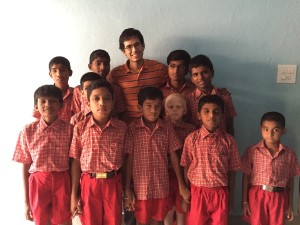
The students at the Mathru School were some of the most inspirational people I have met! My most cherished memories of the trip are with them, and they are my motivation to continue ICTD-like work. A huge thanks to TechBridgeWorld and the Mathru Educational Trust for the Blind for making this summer experience possible!
